
The windmills at Kinderdijk in the
Netherlands are not only a beautiful and impressive sight as they stand, but
they are also an important historical relic and testimony to the ingenuity of
the Dutch people.
Land from the sea
The people of the Netherlands have a long
history of creating farmland from what Nature intended should be the floor of
the sea! Land reclamation began in about 1000 AD with the building of dykes
(sea walls) to prevent the sea from inundating the low-lying land of Holland and
Utrecht.
Efforts to drain marshland and create new
farmland began in the 14th century with the digging of canals and
regulation of the flow of water through a network of sluices and reservoirs. The
new farmland proved to be fertile and peaty, and ideal for pasture and
crop-growing.
However, the process of drainage behind the
dykes caused the reclaimed land to sink below the level of the sea and
therefore become subject to flooding from both the sea and the major rivers
that flow through the region (notably the Rhine and its distributaries). A
method was needed to lift excess water from the farmland (known as polder land)
so that it could be deposited on the other side of the dykes.
Windmills as pumps
The Dutch did not invent the windmill (the
Persians of the 9th century had that honour), but they must be
credited for appreciating the potential of wind power to pump water in large
quantities.
Windmills were erected in the Netherlands from
the early 18th century to power rotary iron scoops that lifted water
from the fields into reservoirs that were then emptied at low tide. Thousands
of windmills were built, but they were gradually replaced by steam-powered
pumps when the technology became available. However, some windmills still
stand, and those at Kinderdijk are particularly impressive.
The Kinderdijk World Heritage Site
The site, which is to the east of
Rotterdam, consists of a network of dykes, reservoirs and pumping station as
well as windmills. The district at one time boasted 150 windmills, but only 28
remain today, of which 19 are within the area covered by the World Heritage
site. They were built between 1738 and 1740 and are kept in full working order,
although their function as pumps has not been needed since the 1940s. They are,
however, still available in reserve should the modern diesel-generated pumps
break down.
The windmills that form such an impressive
sight as they stand in a row are known as “ground sailers”, because their sails
come to within 30 centimetres of the ground. The towers were built from brick
and wood and most are of the “bonnet” design, which means that the top sections
revolve in order to catch the wind.
The Kinderdijk windmills were declared a
World Heritage site in 1997.
© John Welford
No comments:
Post a Comment